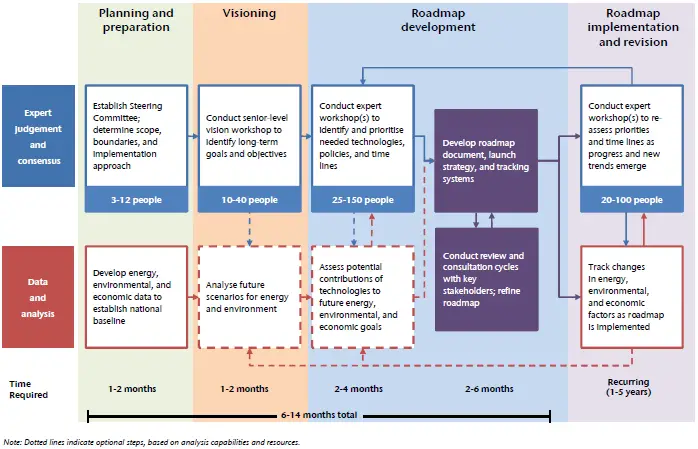A Technology Roadmap is a specialized type of strategic plan that outlines technology activities that an organization can undertake over a specified time frame to achieve stated program and technology goals and outcomes. It’s a plan that applies to a new product or process, or to emerging technology.
Definition: A technology roadmap is a graphical document that illustrates the adoption of technology over time on a project or within an organization.
Purpose of Technology Roadmap
The main purpose of a Technology Roadmap is to show the insertion points of technologies into product design and development and forecasting. Other purposes include:
- Helps reach a consensus about a set of needs and the technologies required to satisfy those needs
- Provides a mechanism to help forecast technology development
- Provides a framework to help plan and coordinate technology developments
Benefits of a Technology Roadmap
A technology roadmap is very beneficial to any organization. The main benefits are:
- Helps understand current and future needs
- Helps sets goals and initiatives
- Enhances communication
- Sets milestones to follow
- Helps organize resources more efficiently
- Provides status reports
Technology Roadmap Development Process
A Technology Roadmap development process should ensure that a roadmap identifies mutual goals and determines specific and achievable technology tasks and actions towards realizing a common vision. On average, it takes six to 14 months to develop a roadmap. The process includes two types of activities (Expert Judgment/Consensus and Data and Analysis) and four phases (Planning and Preparation, Visioning, Roadmap Development, and Roadmap Implementation and Revision). After a roadmap is completed, implementation and updating ensure the complete realization of the vision and goals. [1]
Phases of Technology Roadmap Development
There are four phases that are associated with developing a technology Roadmap. These phases are:
- Phase 1: Planning and Preparation
- Phase 2: Visioning
- Phase 3: Roadmap Development and Roadmap Implementation
- Phase 4: Revision

Phase 3: Technology Roadmap Development
There are seven (7) steps in Phase 3 associated with the actual development of a technology roadmap. These steps are listed below.
- Step 1: Identify product and priorities
- Step 2: Identify and assess critical system requirements and targets
- Step 3: Specify major technology areas, drivers, and targets
- Step 4: Identify technology alternatives
- Step 5: Develop technology timelines
- Step 6: Recommend technology alternatives to be pursued
- Step 7: Create the actual technology roadmap using a template
Technology Roadmap Template
Using a technology template is a good tool in developing a roadmap. A template will guide you and make sure you address all the key aspects of a roadmap. A template should include detailed timelines so everyone understanding when technology should become available. A lot of organizations create their own technology roadmap using current software tools on the market.
Types of Technology Roadmaps
There are two (2) main different types of technology roadmaps which are: [3]
- Product Technology Roadmap: driven by product/process needs.
- Emerging Technology Roadmap: differs from a product technology roadmap in two ways:
- They lack the broader product context provided by the product technology roadmap.
- They focus on (1) forecasting the development and commercialization of a new or emerging technology, (2) the competitive position of a company with respect to that technology, and (3) how the emerging technology and the company’s competitive position will develop
Technology Roadmap Best Practices
An effective Technology Road-mapping process maximizes participants’ engagement in creating the plan, thereby building consensus and increasing the likelihood that those involved will implement the roadmap priorities.
Technology Roadmap Updates
A technology roadmap is a “Living Document” that evolves in the sense that the process does not stop when the document is published. Rather, the roadmap evolves as progress is made, external factors change and more information becomes available. The frequency with which a roadmap is updated depends largely on the time frame under consideration. Typically, national-level roadmaps are updated periodically (e.g., every two to five years). Technology-specific roadmaps are sometimes updated more frequently to reflect progress, changes in available resources, or scheduling considerations.
Technology Release Roadmap
The Technology Release Roadmap (TRR) provides a projection of when export licenses will be required in support of the Acquisition Process and critical Milestones regarding national disclosure policy implementation on acquisition programs involving international involvement by foreign industry. The TRR is conducted prior to the Engineering, Manufacturing, and Development (EMD Phase. The Program Manager (PM) should prepare an export control TRR as part of their Technology Assessment/Control Plan (TA/CP). The TRR must be consistent with the program’s TA/CP, Security Classification Guide (SCG), and other disclosure guidance.
Technology Readiness Assessment (TRA)
AcqLinks and References:
- [1] Energy Technology Roadmap Guide
- [3] White Paper: Marie L. Garcia, Olin H. Bray (1997) “Fundamentals of Technology Road-mapping” Sandia National Labs
Updated: 7/21/2021
Rank: G44.9
